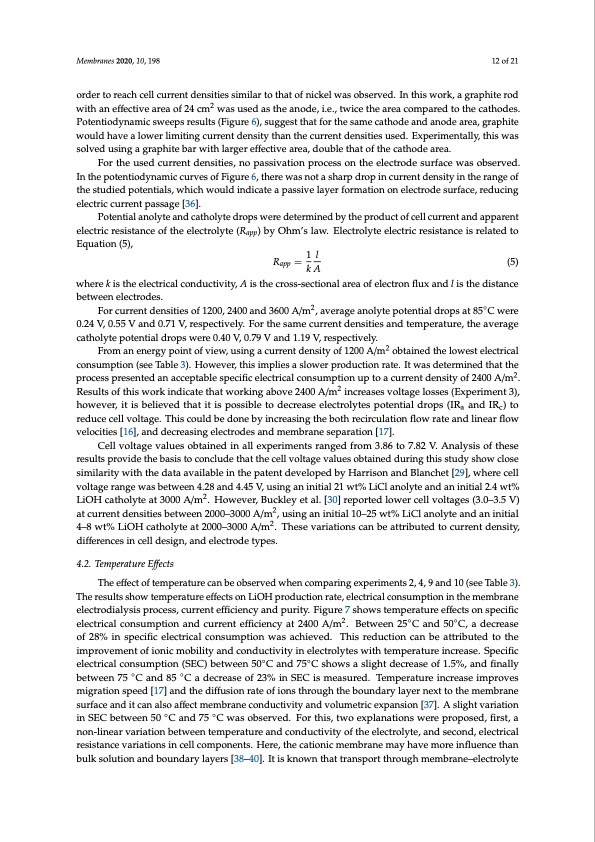
PDF Publication Title:
Text from PDF Page: 012
Membranes 2020, 10, 198 12 of 21 order to reach cell current densities similar to that of nickel was observed. In this work, a graphite rod with an effective area of 24 cm2 was used as the anode, i.e., twice the area compared to the cathodes. Potentiodynamic sweeps results (Figure 6), suggest that for the same cathode and anode area, graphite would have a lower limiting current density than the current densities used. Experimentally, this was solved using a graphite bar with larger effective area, double that of the cathode area. For the used current densities, no passivation process on the electrode surface was observed. In the potentiodynamic curves of Figure 6, there was not a sharp drop in current density in the range of the studied potentials, which would indicate a passive layer formation on electrode surface, reducing electric current passage [36]. Potential anolyte and catholyte drops were determined by the product of cell current and apparent electric resistance of the electrolyte (Rapp) by Ohm’s law. Electrolyte electric resistance is related to Equation (5), Rapp = 1k Al (5) where k is the electrical conductivity, A is the cross-sectional area of electron flux and l is the distance between electrodes. For current densities of 1200, 2400 and 3600 A/m2, average anolyte potential drops at 85◦C were 0.24 V, 0.55 V and 0.71 V, respectively. For the same current densities and temperature, the average catholyte potential drops were 0.40 V, 0.79 V and 1.19 V, respectively. From an energy point of view, using a current density of 1200 A/m2 obtained the lowest electrical consumption (see Table 3). However, this implies a slower production rate. It was determined that the process presented an acceptable specific electrical consumption up to a current density of 2400 A/m2. Results of this work indicate that working above 2400 A/m2 increases voltage losses (Experiment 3), however, it is believed that it is possible to decrease electrolytes potential drops (IRa and IRc) to reduce cell voltage. This could be done by increasing the both recirculation flow rate and linear flow velocities [16], and decreasing electrodes and membrane separation [17]. Cell voltage values obtained in all experiments ranged from 3.86 to 7.82 V. Analysis of these results provide the basis to conclude that the cell voltage values obtained during this study show close similarity with the data available in the patent developed by Harrison and Blanchet [29], where cell voltage range was between 4.28 and 4.45 V, using an initial 21 wt% LiCl anolyte and an initial 2.4 wt% LiOH catholyte at 3000 A/m2. However, Buckley et al. [30] reported lower cell voltages (3.0–3.5 V) at current densities between 2000–3000 A/m2, using an initial 10–25 wt% LiCl anolyte and an initial 4–8 wt% LiOH catholyte at 2000–3000 A/m2. These variations can be attributed to current density, differences in cell design, and electrode types. 4.2. Temperature Effects The effect of temperature can be observed when comparing experiments 2, 4, 9 and 10 (see Table 3). The results show temperature effects on LiOH production rate, electrical consumption in the membrane electrodialysis process, current efficiency and purity. Figure 7 shows temperature effects on specific electrical consumption and current efficiency at 2400 A/m2. Between 25◦C and 50◦C, a decrease of 28% in specific electrical consumption was achieved. This reduction can be attributed to the improvement of ionic mobility and conductivity in electrolytes with temperature increase. Specific electrical consumption (SEC) between 50◦C and 75◦C shows a slight decrease of 1.5%, and finally between 75 ◦C and 85 ◦C a decrease of 23% in SEC is measured. Temperature increase improves migration speed [17] and the diffusion rate of ions through the boundary layer next to the membrane surface and it can also affect membrane conductivity and volumetric expansion [37]. A slight variation in SEC between 50 ◦C and 75 ◦C was observed. For this, two explanations were proposed, first, a non-linear variation between temperature and conductivity of the electrolyte, and second, electrical resistance variations in cell components. Here, the cationic membrane may have more influence than bulk solution and boundary layers [38–40]. It is known that transport through membrane–electrolytePDF Image | Battery Grade Li Hydroxide by Membrane Electrodialysis

PDF Search Title:
Battery Grade Li Hydroxide by Membrane ElectrodialysisOriginal File Name Searched:
membranes-10-00198.pdfDIY PDF Search: Google It | Yahoo | Bing
Product and Development Focus for Infinity Turbine
ORC Waste Heat Turbine and ORC System Build Plans: All turbine plans are $10,000 each. This allows you to build a system and then consider licensing for production after you have completed and tested a unit.Redox Flow Battery Technology: With the advent of the new USA tax credits for producing and selling batteries ($35/kW) we are focussing on a simple flow battery using shipping containers as the modular electrolyte storage units with tax credits up to $140,000 per system. Our main focus is on the salt battery. This battery can be used for both thermal and electrical storage applications. We call it the Cogeneration Battery or Cogen Battery. One project is converting salt (brine) based water conditioners to simultaneously produce power. In addition, there are many opportunities to extract Lithium from brine (salt lakes, groundwater, and producer water).Salt water or brine are huge sources for lithium. Most of the worlds lithium is acquired from a brine source. It's even in seawater in a low concentration. Brine is also a byproduct of huge powerplants, which can now use that as an electrolyte and a huge flow battery (which allows storage at the source).We welcome any business and equipment inquiries, as well as licensing our turbines for manufacturing.| CONTACT TEL: 608-238-6001 Email: greg@infinityturbine.com | RSS | AMP |